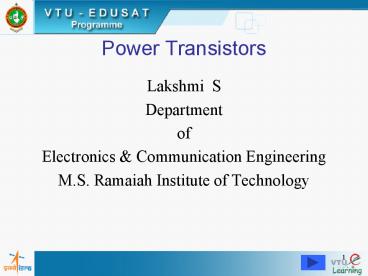Power Transistors - PowerPoint PPT Presentation
1 / 38
Title:
Power Transistors
Description:
References for further information. Power Electronics by Mohan ... 34. Without Clamping. 35. The load resistance RC should satisfy the condition. IC IL ... – PowerPoint PPT presentation
Number of Views:6033
Avg rating:3.0/5.0
Title: Power Transistors
1
Power Transistors
- Lakshmi S
- Department
- of
- Electronics Communication Engineering
- M.S. Ramaiah Institute of Technology
1
2
References for further information
- Power Electronics by Mohan / Undreland / Robbins.
- Power Electronics by Dr. P.S. Bimbhra,
- Power Electronics by Muhammad H Rashid
2
3
Overview of the Session
- Structural features of power transistors.
- Power transistor characteristics.
- Switching characteristics.
- Switching limits.
- Base drive control.
3
4
Introduction to Power Transistors
- Have controlled turn-on turn-off
characteristics. - Used as switches in dc-ac and dc-dc converters.
- Switching speeds are higher than Thyristors.
- Voltage current ratings are lower than
thyristors.
4
5
Types of Power Transistors
- Bi-polar junction transistors (BJTs).
- Metal oxide semiconductor field effect
transistors (MOSFETs). - Static induction transistors (SITs).
- Insulated gate bi-polar transistors (IGBTs).
5
6
BJTs
- Signal level transistor structure
6
7
Power Transistor Structure
7
8
Vertical Cross-section
8
9
Steady State Characteristics of Signal level
BJT
9
10
Steady State Characteristics of Power Transistor
10
11
Transfer Characteristics
11
12
Transistor as a Switch
12
13
13
14
Problems
- Problem 1 (July / August 2004)
- Calculate
- Forced ?.
- ODF.
- Power Loss PT
14
15
15
16
16
17
- Problem 2 (Jan / Feb 2005)
- Sketch device current waveform
- w.r.t. to input pulse.
- Calculate
- ICS.
- RB for an ODF of 2.
- Power Loss PT
17
18
18
19
19
20
20
21
Transient Model of BJT
21
22
Switching Characteristics of BJT
22
23
Switching Limits
- Breakdown voltages
- BVSUS
- BVCEO
- BVCBO
23
24
- Second
- Breakdown
24
25
- Forward
- biased safe
- operating
- area
- (FBSOA)
25
26
- Reverse
- biased safe
- operating
- area
- (RBSOA)
26
27
- Power Derating
-
- Thermal Equivalent
-
Circuit of Transistor
27
28
Base Drive Control
- Used for increasing switching speeds.
- Types
- Turn-on control.
- Turn-off control.
- Proportional base control.
- Antisaturation control.
28
29
Turn-on Control
29
30
30
31
Turn-off Control
31
32
Turn-on Turn-off Control
32
33
Proportional Base Control
33
34
Antisaturation Control
Without Clamping
34
35
35
36
- The load resistance RC should satisfy the
condition - IC gt IL
- ?IB gt IL
- ?IBRC gt ILRC
- But ILRC VCC VBE VD1 VD2
36
37
Advantages of BJTs
- Have high switching frequencies.
- Turn-on losses are small.
- Controlled turn-on turn-off characteristics.
- No commutation circuit required.
37
38
Demerits of BJT
- Drive circuit is complex.
- Has the problem of charge storage.
- Has the problem of second breakdown.
- Cannot be used in parallel due to problems of
negative temperature coefficients.
38

